2011 Peugeot Partner height adjustment
[x] Cancel search: height adjustmentPage 10 of 200
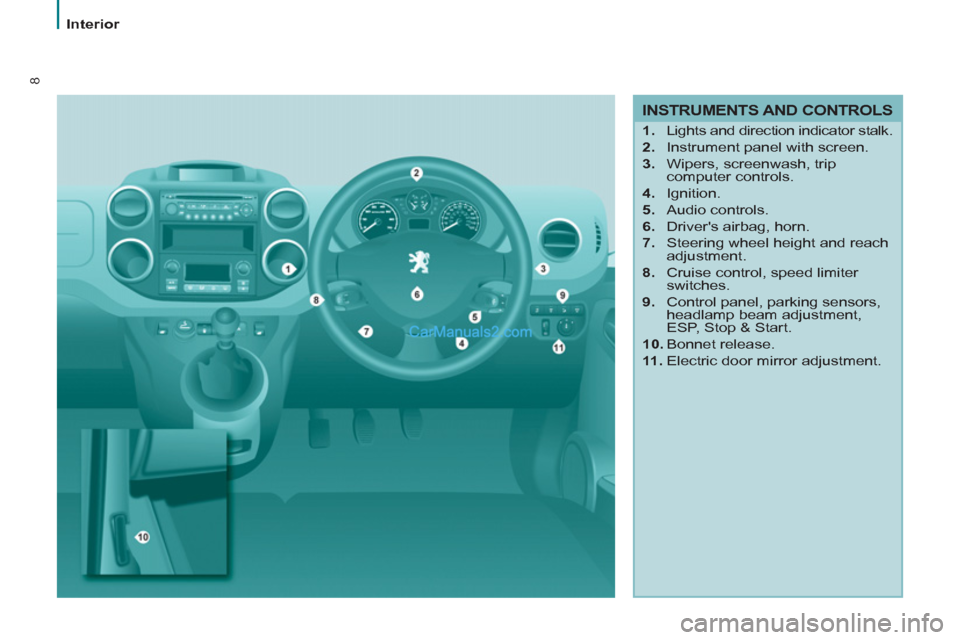
8
INSTRUMENTS AND CONTROLS
1.
Lights and direction indicator stalk.
2.
Instrument panel with screen.
3.
Wipers, screenwash, trip
computer controls.
4.
Ignition.
5.
Audio controls.
6.
Driver's airbag, horn.
7.
Steering wheel height and reach
adjustment.
8.
Cruise control, speed limiter
switches.
9.
Control panel, parking sensors,
headlamp beam adjustment,
ESP, Stop & Start.
10.
Bonnet release.
11 .
Electric door mirror adjustment.
Interior
Page 12 of 200
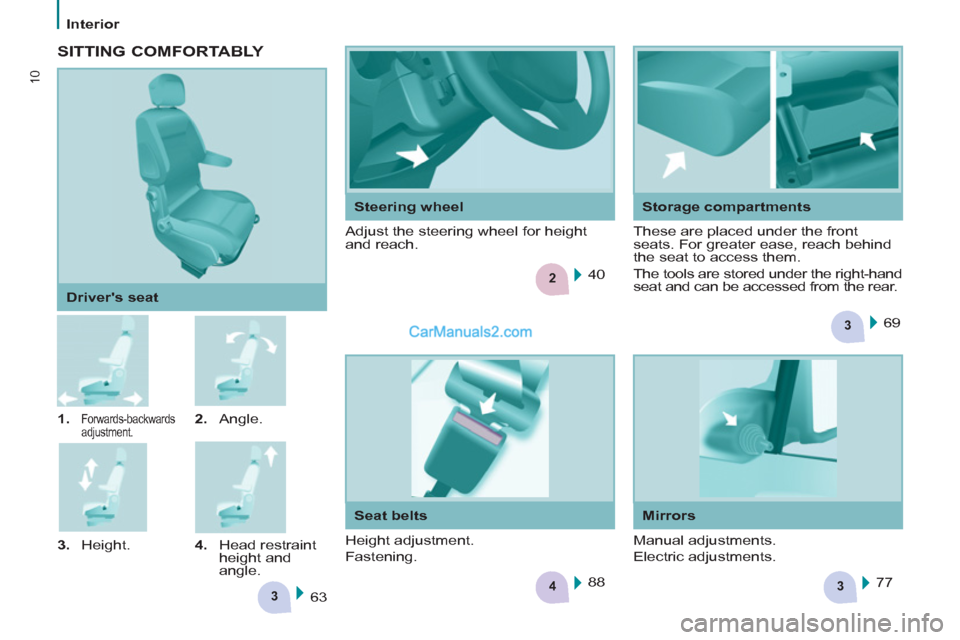
3
43
2
3
10
Interior
1.
Forwards-backwards
adjustment.
2.
Angle.
3.
Height.
4.
Head restraint
height and
angle.
Driver's seat
63 69
40
77 88
SITTING COMFORTABLY
Steering wheel
Adjust the steering wheel for height
and reach.
Storage compartments
These are placed under the front
seats. For greater ease, reach behind
the seat to access them.
The tools are stored under the right-hand
seat and can be accessed from the rear.
Seat belts
Height adjustment.
Fastening.
Mirrors
Manual adjustments.
Electric adjustments.
Page 42 of 200
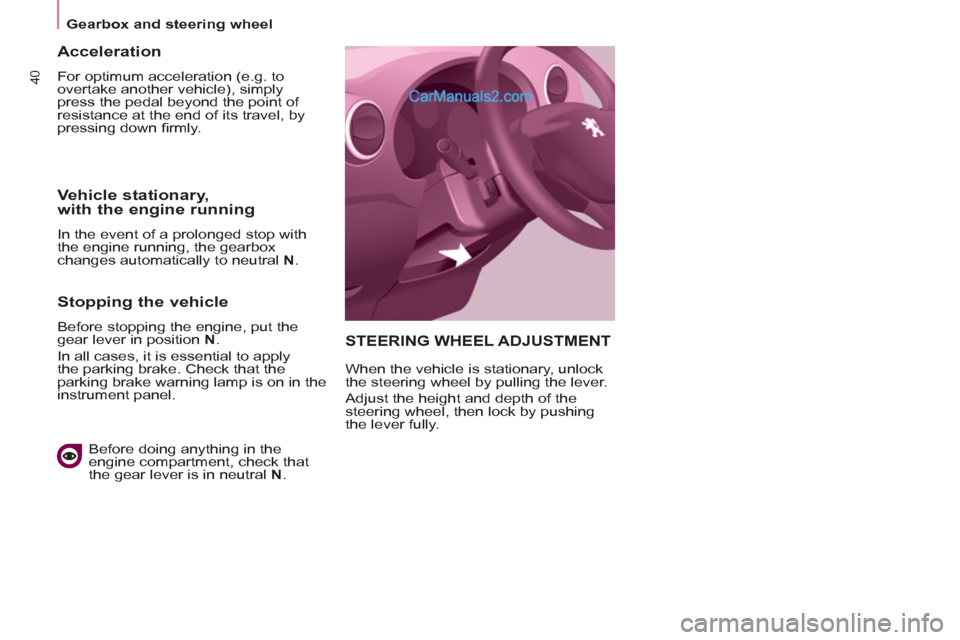
40
Gearbox and steering wheel
STEERING WHEEL ADJUSTMENT
When the vehicle is stationary, unlock
the steering wheel by pulling the lever.
Adjust the height and depth of the
steering wheel, then lock by pushing
the lever fully.
Acceleration
For optimum acceleration (e.g. to
overtake another vehicle), simply
press the pedal beyond the point of
resistance at the end of its travel, by
pressing down fi rmly.
Vehicle stationary,
with the engine running
In the event of a prolonged stop with
the engine running, the gearbox
changes automatically to neutral N
.
Stopping the vehicle
Before stopping the engine, put the
gear lever in position N
.
In all cases, it is essential to apply
the parking brake. Check that the
parking brake warning lamp is on in the
instrument panel.
Before doing anything in the
engine compartment, check that
the gear lever is in neutral N
.
Page 65 of 200
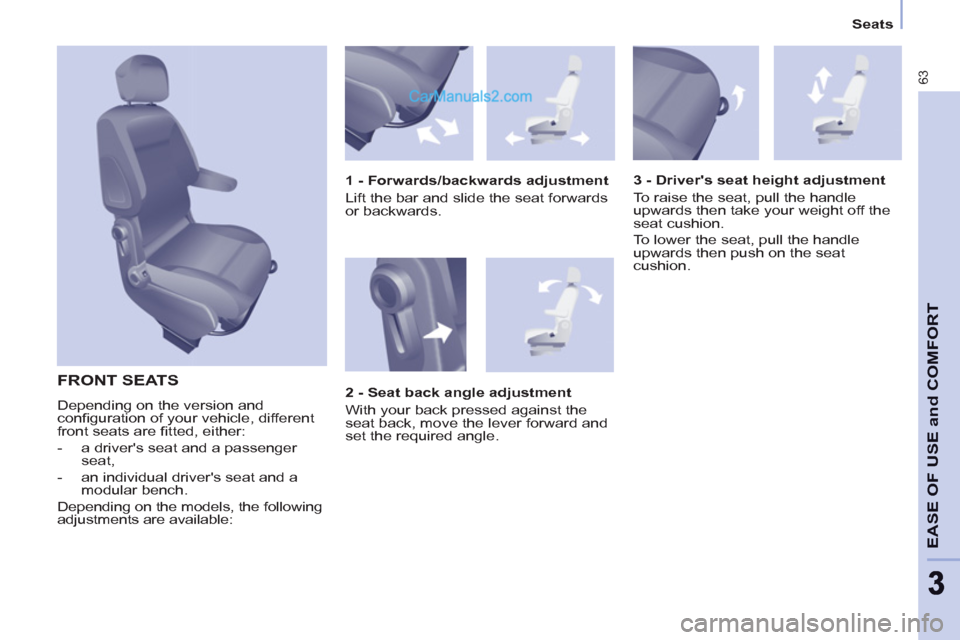
63
EASE OF USE and COMFOR
T
33
Seats
FRONT SEATS
Depending on the version and
confi guration of your vehicle, different
front seats are fi tted, either:
- a driver's seat and a passenger
seat,
- an individual driver's seat and a
modular bench.
Depending on the models, the following
adjustments are available:
1 - Forwards/backwards adjustment
Lift the bar and slide the seat forwards
or backwards.
3 - Driver's seat height adjustment
To raise the seat, pull the handle
upwards then take your weight off the
seat cushion.
To lower the seat, pull the handle
upwards then push on the seat
cushion.
2 - Seat back angle adjustment
With your back pressed against the
seat back, move the lever forward and
set the required angle.
Page 66 of 200
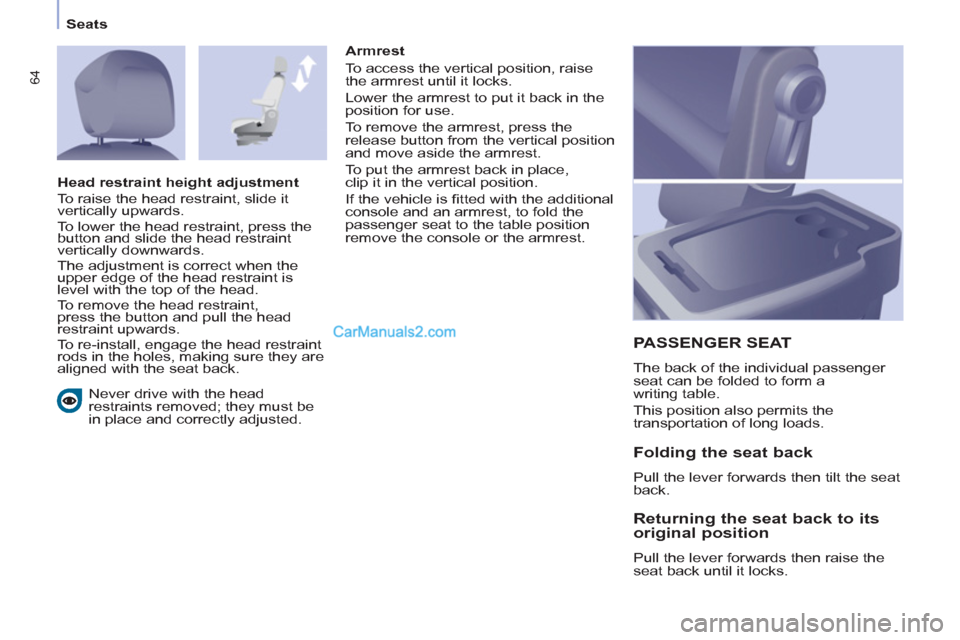
64
Seats
Never drive with the head
restraints removed; they must be
in place and correctly adjusted.
PASSENGER SEAT
The back of the individual passenger
seat can be folded to form a
writing table.
This position also permits the
transportation of long loads.
Head restraint height adjustment
To raise the head restraint, slide it
vertically upwards.
To lower the head restraint, press the
button and slide the head restraint
vertically downwards.
The adjustment is correct when the
upper edge of the head restraint is
level with the top of the head.
To remove the head restraint,
press the button and pull the head
restraint upwards.
To re-install, engage the head restraint
rods in the holes, making sure they are
aligned with the seat back.
Folding the seat back
Pull the lever forwards then tilt the seat
back.
Returning the seat back to its
original position
Pull the lever forwards then raise the
seat back until it locks.
Armrest
To access the vertical position, raise
the armrest until it locks.
Lower the armrest to put it back in the
position for use.
To remove the armrest, press the
release button from the vertical position
and move aside the armrest.
To put the armrest back in place,
clip it in the vertical position.
If the vehicle is fi tted with the additional
console and an armrest, to fold the
passenger seat to the table position
remove the console or the armrest.
Page 90 of 200
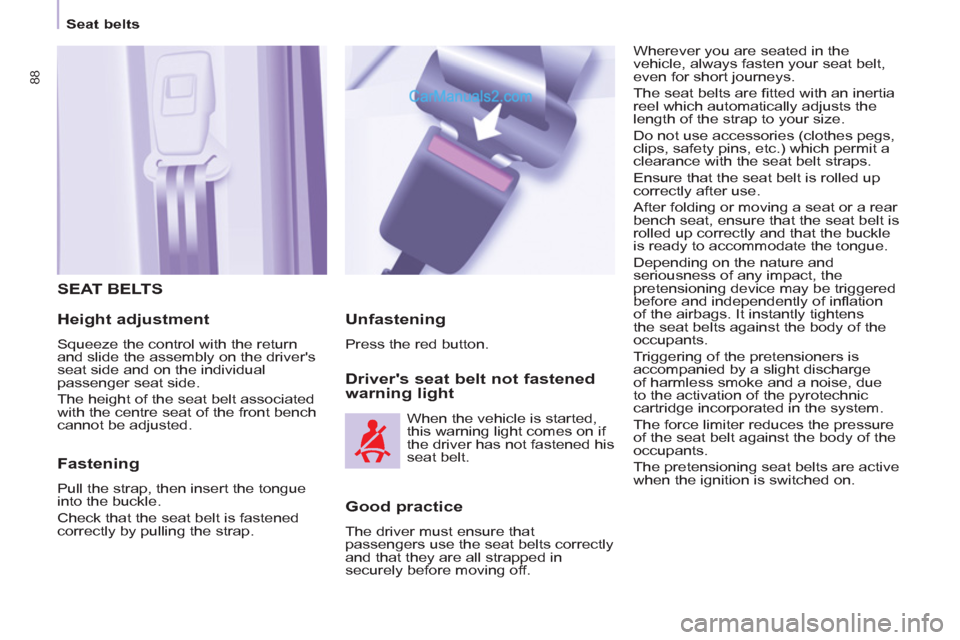
Seat belts
88
SEAT BELTS
Height adjustment
Squeeze the control with the return
and slide the assembly on the driver's
seat side and on the individual
passenger seat side.
The height of the seat belt associated
with the centre seat of the front bench
cannot be adjusted.
Fastening
Pull the strap, then insert the tongue
into the buckle.
Check that the seat belt is fastened
correctly by pulling the strap.
Driver's seat belt not fastened
warning light
Wherever you are seated in the
vehicle, always fasten your seat belt,
even for short journeys.
The seat belts are fi tted with an inertia
reel which automatically adjusts the
length of the strap to your size.
Do not use accessories (clothes pegs,
clips, safety pins, etc.) which permit a
clearance with the seat belt straps.
Ensure that the seat belt is rolled up
correctly after use.
After folding or moving a seat or a rear
bench seat, ensure that the seat belt is
rolled up correctly and that the buckle
is ready to accommodate the tongue.
Depending on the nature and
seriousness of any impact, the
pretensioning device may be triggered
before and independently of infl ation
of the airbags. It instantly tightens
the seat belts against the body of the
occupants.
Triggering of the pretensioners is
accompanied by a slight discharge
of harmless smoke and a noise, due
to the activation of the pyrotechnic
cartridge incorporated in the system.
The force limiter reduces the pressure
of the seat belt against the body of the
occupants.
The pretensioning seat belts are active
when the ignition is switched on.
Unfastening
Press the red button.
When the vehicle is started,
this warning light comes on if
the driver has not fastened his
seat belt.
Good practice
The driver must ensure that
passengers use the seat belts correctly
and that they are all strapped in
securely before moving off.
Page 193 of 200
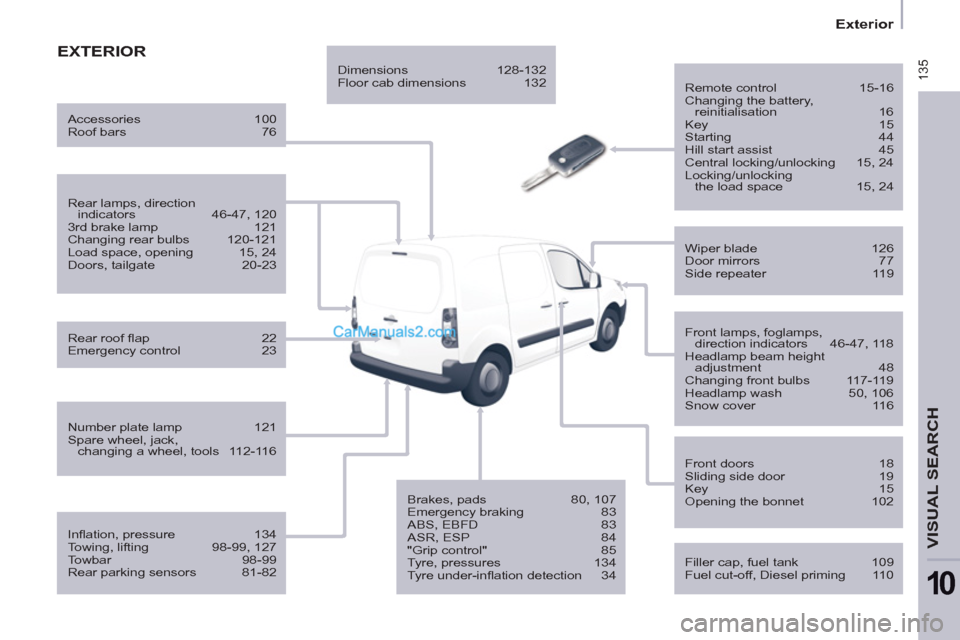
135
Exterior
VISUAL SEARCH
10
EXTERIOR
Remote control 15-16
Changing the battery,
reinitialisation 16
Key 15
Starting 44
Hill start assist 45
Central locking/unlocking 15, 24
Locking/unlocking
the load space 15, 24
Filler cap, fuel tank 109
Fuel cut-off, Diesel priming 110
Wiper blade 126
Door mirrors 77
Side repeater 119
Front lamps, foglamps,
direction indicators 46-47, 118
Headlamp beam height
adjustment 48
Changing front bulbs 117-119
Headlamp wash 50, 106
Snow cover 116
Front doors 18
Sliding side door 19
Key 15
Opening the bonnet 102
Infl ation, pressure 134
Towing, lifting 98-99, 127
Towbar 98-99
Rear parking sensors 81-82
Number plate lamp 121
Spare wheel, jack,
changing a wheel, tools 112-116
Rear lamps, direction
indicators 46-47, 120
3rd brake lamp 121
Changing rear bulbs 120-121
Load space, opening 15, 24
Doors, tailgate 20-23
Accessories 100
Roof bars 76
Rear roof fl ap 22
Emergency control 23
Dimensions 128-132
Floor cab dimensions 132
Brakes, pads 80, 107
Emergency braking 83
ABS, EBFD 83
ASR, ESP 84
"Grip control" 85
Tyre, pressures 134
Tyre under-infl ation detection 34
Page 194 of 200
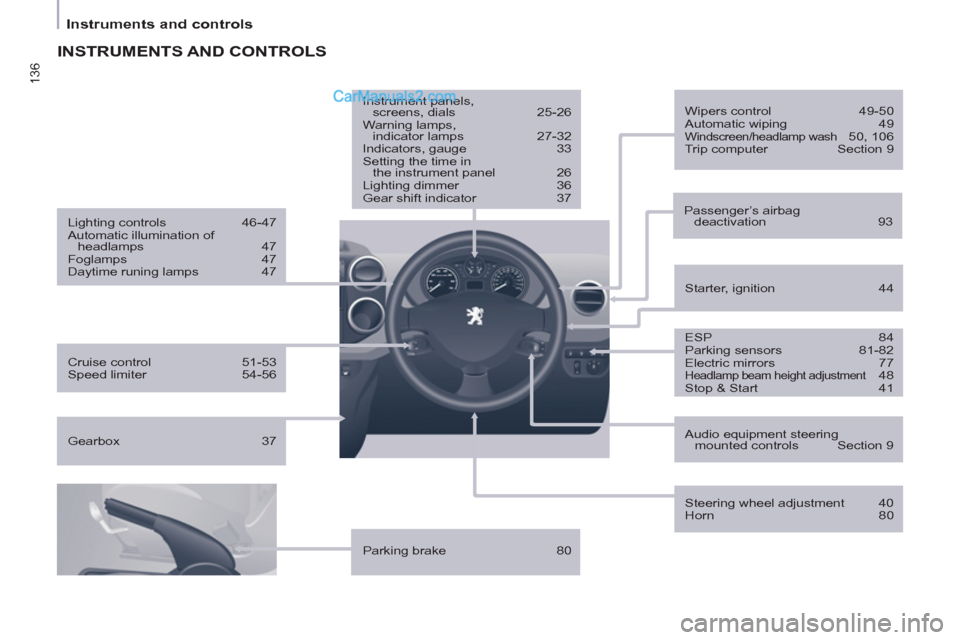
136
Instruments and controls
INSTRUMENTS AND CONTROLS
ESP 84
Parking sensors 81-82
Electric mirrors 77
Headlamp beam height adjustment 48
Stop & Start 41
Starter, ignition 44
Wipers control 49-50
Automatic wiping 49
Windscreen/headlamp wash 50, 106
Trip computer Section 9
Cruise control 51-53
Speed limiter 54-56
Lighting controls 46-47
Automatic illumination of
headlamps 47
Foglamps 47
Daytime runing lamps 47
Parking brake 80
Instrument panels,
screens, dials 25-26
Warning lamps,
indicator lamps 27-32
Indicators, gauge 33
Setting the time in
the instrument panel 26
Lighting dimmer 36
Gear shift indicator 37
Audio equipment steering
mounted controls Section 9
Steering wheel adjustment 40
Horn 80
Passenger’s airbag
deactivation 93
Gearbox 37